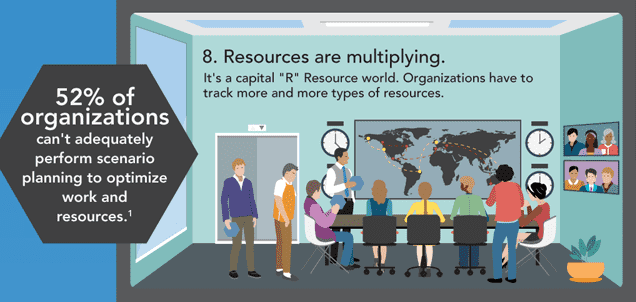
In my last post, I discussed how “Technology is everywhere.” As ubiquitous, complex and necessary as technology is, it still only counts as one of the many resources that organizations must integrate into a work and resource management world. Resources are multiplying, making it the eighth and last of our business forces potentially thwarting organizations.
- Outcomes are different
- Capabilities must be strategic
- Work methodologies are proliferating
- Unstructured work is exploding
- Plans are even more critical
- Teams are virtual and global
- Technology is everywhere
- Resources are multiplying
Here’s a snippet of me discussing the expanding definition of resources during our customer conference last year:
Resources Are Multiplying
People and finances are no longer the only resources that organizations must track if they want to meet their business objectives. Today, resources are anything that help achieve a goal, such as assets, services, applications, virtual teams, technology, locations, connected devices that comprise the “Internet of Things,” and much more.
As research firm Ventana has advised: “Organizations should have the capacity to plan and define activities and tasks – they should know the available capacity of their resources, which encompasses not just people but also manufacturing and customer distribution potential of their retail locations. Also, organizations should be nimble, able to shift priorities, address issues and task resources to get them completed in an acceptable time window.”
Resource capacity planning is difficult enough when it is limited to employees. Our 2016 Resource Management and Capacity Planning Benchmark Study corroborated our findings over the past several years: Organizations continually overcommit their people resources, limiting growth and innovation.
In fact, in our study 61 percent of organizations on the low end of the maturity scale said they find it extremely difficult to consider capacity in the planning process. Twenty percent of theses companies do not take capacity into account at all before committing to projects or work. This puts organizations at risk of missing time to market or project timelines.
Now think of the complexity of getting a handle on all global resources beyond people and finances, for all work – not just for structured projects managed by a PPM solution, but unstructured tasks and activities as well. In its research, Ventana found that 52 percent of organizations cannot adequately perform scenario planning to optimize work and resources. The risks of failing to execute on plans and achieve growth objectives are higher than ever.
This is why work and resource management is so important. Ventana writes that work and resource management “explores the use of dedicated software and technology to support continuous organizational optimization. It looks at work that is assigned and conducted by resources that may be people-, technology- or asset-based and that can be located anywhere in the organization or be geographically dispersed.”
Ventana continues that organizations “should have available an application that can provide a unified view of work and resources rather than being constrained or complicated by a myriad of applications not designed for this essential element.”
We’ll explore this more in my next post. Now that I’ve covered all eight forces, I’ll focus on how work and resource management can help you manage them to your benefit for faster innovation, execution, and growth.





